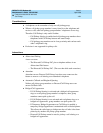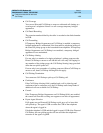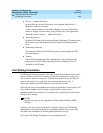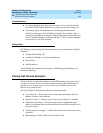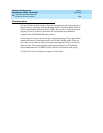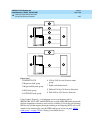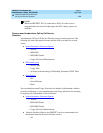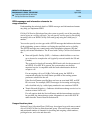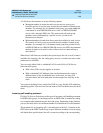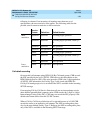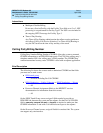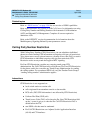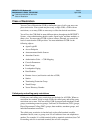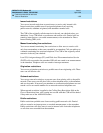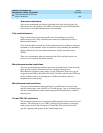
DEFINITY ECS Release 8.2
Administrator’s Guide
555-233-506
Issue 1
April 2000
Features and technical reference
1299Call-by-Call Service Selection
20
ISDN messages and information elements for
usage allocation
Understanding the technical details of ISDN messages and information elements
may help you implement ISDN.
Call-by-Call Service Selection allows the system to specify one of the preceding
service types on a call-by-call basis. You can specify service types by classifying
incoming calls to an ISDN Call-By-Call trunk group using the called-party’s
number.
You can also specify service types with a SETUP message that indicates the intent
of the originating system to initiate a call using the specified service or facility.
The SETUP message may contain units called information elements (IE) that
specify call-related information. The IE used with Call-by-Call Service Selection
are:
■ Network-Specific Facility (NSF)
—
Indicates which facilities or services
are to be used to complete the call (typically not used outside the US and
Canada).
The system also checks all incoming ISDN trunk calls for the presence of
an NSF IE. If an NSF IE is present, the system makes sure that the
requested service is compatible with the trunk administration before it
accepts a call.
For an outgoing call on a Call-By-Call trunk group, the NSF IE is
constructed using the Service/Feature specified on the routing-pattern
preference selected for the call.
If the Service/Feature specified does not have an associated NSF, an NSF
IE is not sent. For example, SETUP messages for incoming and outgoing
calls classified only by a called-party number do not contain an NSF IE.
■ Transit Network Selection
—
Indicates which interexchange carrier is to be
used on an inter-LATA call.
If a call requires both the Service/Feature and the interexchange carrier to
be specified, the interexchange carrier information is sent in the NSF IE
rather than the Transit Network Selection IE.
Usage allocation plans
Optional Usage Allocation Plans (UAP) may be assigned to provide more control
over a Call-by-Call Service Selection trunk group. You can allocate a minimum
and maximum number of channels for incoming and outgoing called numbers,
privileged users, and voice and data calls.



